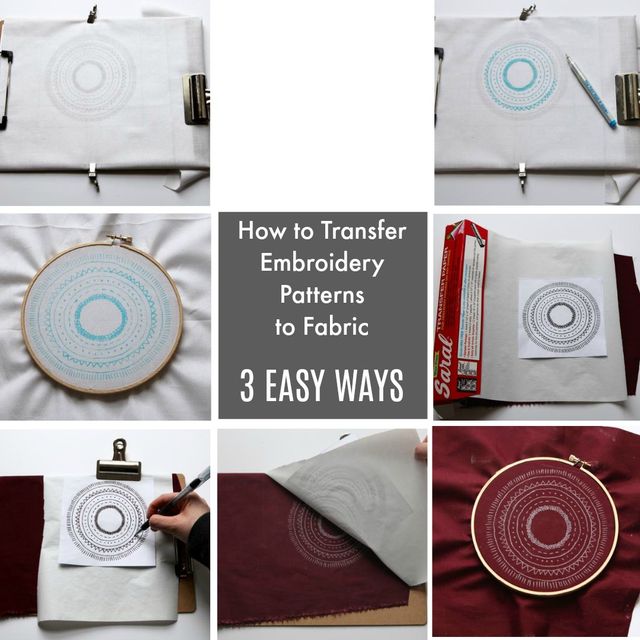
Tracing the pattern directly onto fabric
What you'll need:
Lightweight fabric that is also light in color
Clips or tape
A pencil or Water Soluble Marker
A lightbox or window (optional)
Note: This is arguably the simplest method because it requires no special supplies.

1. Secure your pattern and fabric. As you can see, my fabric is sheer enough that I can see the pattern from underneath. If you can't see the pattern through your fabric, you'll need to add some light. A lightbox makes this process extremely easy, but a sunny window works too. I am using clips to secure my pattern and fabric, but you can also tape each layer down onto the surface on which you are working.

 `
`
2. Trace the design onto your fabric. I love using a water soluble marker because the ink can easily be removed with a little bit of water. You can also use a pencil to trace your design. The pencil marks will be fairly permanent on fabric, but in most cases the lines will be covered by your stitches.

3. That's it! You are now ready to stitch. Stick that fabric in an embroidery hoop and get to work!
+++++
Using an iron transfer pen
What you'll need:
Fabric light enough in color for the black mark to show
Iron-On Transfer Pen
Iron



3. Once you have ironed over all parts of the pattern, lift a corner of the pattern up to check on the transfer. Be careful not to shift the pattern in case more ironing is necessary.

Done! You are now ready to stitch.
+++++
Using transfer paper
What you'll need:
Transfer Paper - available in white, black, and other colors
Contrasting fabric
Clips or tape
A ballpoint pen or sharp pencil

1. Sandwich a piece of the transfer paper between your fabric and printed pattern. Make sure the transfer paper is oriented with the waxy side against your fabric.

2. Secure the pieces together using clips or tape. The last thing you want is something to shift mid-transfer. Start tracing on top of your printed pattern with your drawing utensil. Don't be afraid to give it some pressure.

3. Being careful not to shift your pieces, lift the transfer up to check that your marks are visible.

4. Once the entire pattern is traced, you are done! The transfer paper may have left some residual smudges on your fabric, which can easily be removed with a little water.
And there you have it: three different ways to transfer a PDF embroidery pattern onto fabric! If you'd like to test out this newfound knowledge, you can access this very pattern for free to get started on your own!

This article contains affiliate links. I include links for supplies to make it more convenient for you to get what you need to start your next project. I only include affiliate links for products I use personally and highly recommend.

